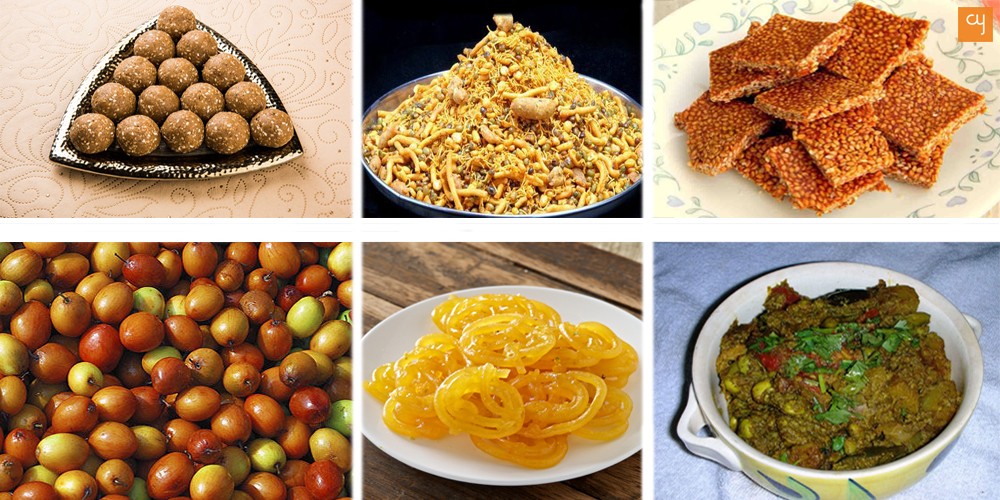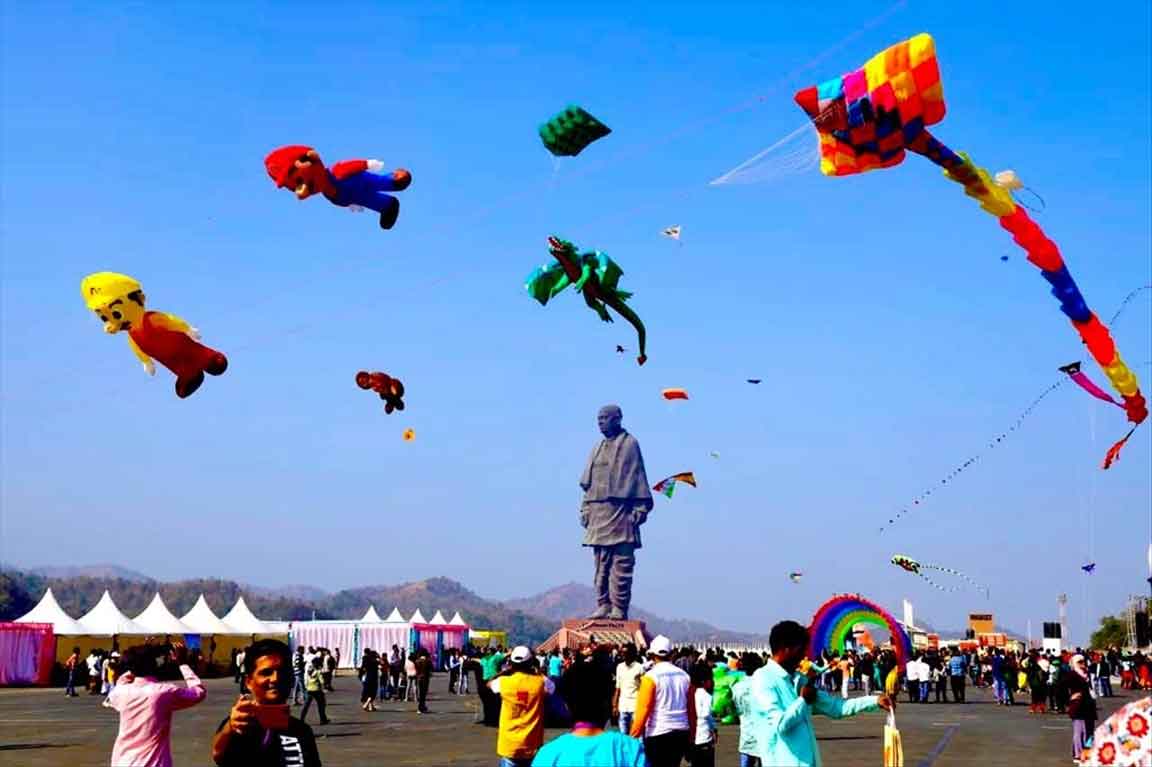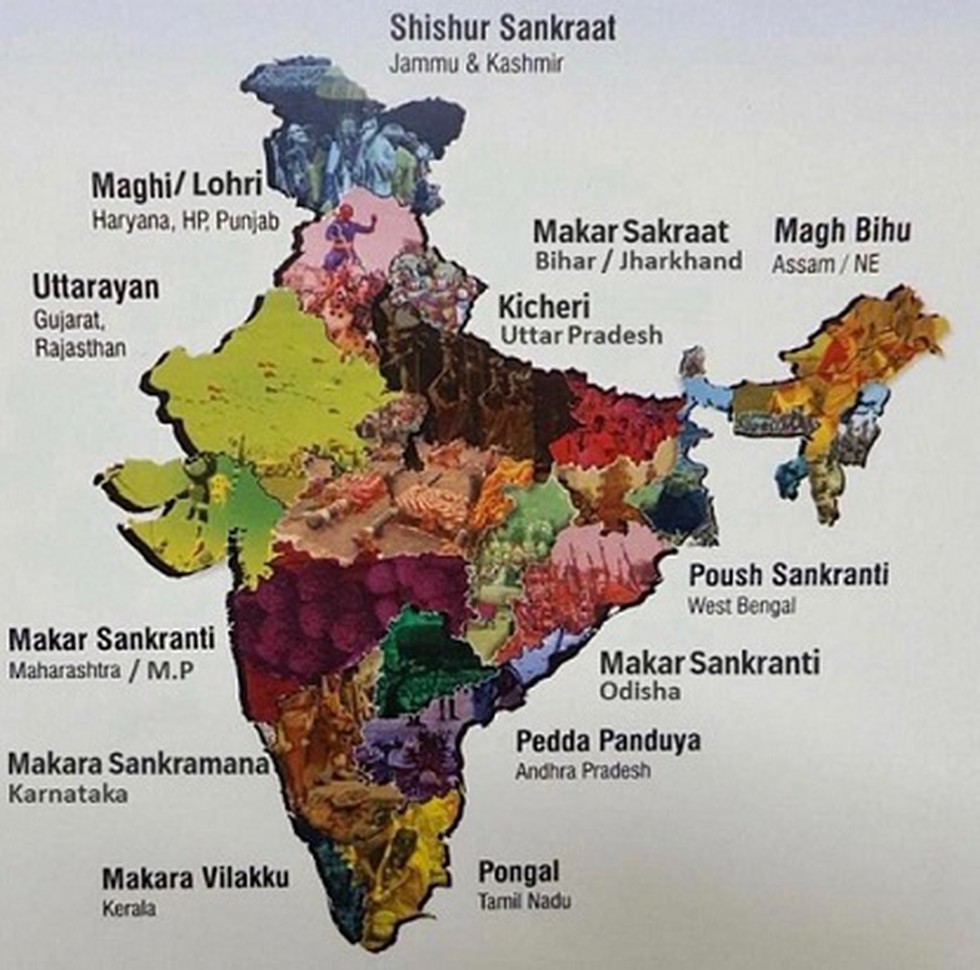The term Uttarayana (commonly Uttarayan) is derived from two different Sanskrit words – "uttara" (North) and "ayana" (movement) – thus indicating a semantic of the northward movement of the Sun on the celestial sphere. This movement begins to occur a day after the winter solstice in December, which occurs around 22 December and continues for a six-month period through to the summer solstice around June 21 (dates vary). This difference is because the solstices are continually precessing at a rate of 50 arcseconds per year due to the precession of the equinoxes, i.e. this difference is the difference between the sidereal and tropical zodiacs. The Surya Siddhanta bridges this difference by juxtaposing the four solstitial and equinoctial points with four of the twelve boundaries of the rashis.[1]
The complement of Uttarayana is Dakshinayana, i.e. the period between Karka sankranti and Makara Sankranti as per the sidereal zodiac and between the Summer solstice and Winter solstice as per the tropical zodiac.[2]
Contents
1 Difference between Uttarayana and Makar Sankranti
2 Uttarayana in various treatises
1) Surya Siddhanta
2) Drik Siddhanta
5 Hindu Puranas
6 References
Difference between Uttarayana and Makar Sankranti
There is a common misconception[3] that Makar Sankranti marks the beginning of Uttarayana. This is because at one point in time Sayana and Nirayana zodiac were the same. Every year sidereal and tropical equinoxes slide by 50 seconds due to axial precession, giving birth to Ayanamsha and causing Makar Sankranti to slide further. When equinox slides it will increase ayanamsha and Makar Sankranti will also slide. This misconception continues as there is not much difference between actual Uttarayana date which occurs a day after winter solstice (of Dec 21) when the sun makes the northward journey, and January 14. However, the difference will be significant as equinoxes slide further. In 272 AD, Makar Sankranti was on Dec 21. In 1000 AD, Makar Sankranti was on Dec 31 and now it falls on January 14. After 9000 years, Makar Sankranti will be in June. Then Makar Sankranti would mark the beginning of Dakshinayana.
However Makar Sankranti still holds importance in Hindu rituals. All Drika Panchanga makers like mypanchang.com, datepanchang, janmabhumi panchang, rashtriya panchang [4] and Vishuddha Siddhanta Panjika use the position of the tropical sun to determine Uttarayana and Dakshinayana.[5]
Foods & sweets that we enjoy in makar-sankranti
On the occasion of Makar Sankranti, people worship Lord Gorakhnath and seek his blessings before beginning the new harvest season. He is being worshipped for prosperous and healthy harvests. It is believed that the hindu yogi was very fond of eating khichdi. It was his favourite food.
Makar Sankranti is a festival celebrated across India in different ways. In Gujarat, people celebrate this festival with their family and friends. Surya pooja and kite flying are done together but more importantly, they prepare some Indian dishes which are not only delicious but also healthy to eat during winter. Here we’ve compiled 6 of these yummy Indian foods which you can easily prepare at your home to add some deliciousness along with fun for the upcoming Uttarayan/Makar Sankranti.
1. Undhiyu:
Undhiyu or Undhiya is one of the favourite foods of Gujarat. It’s made with different types of vegetables and spices which also make it healthy and nutritious. During Uttarayan, most of the Gujarati people prefer Undhiyu and Puri as their meal for the day. Several restaurants and Halwai shops offer this delicious food during Uttarayan only.
It's very simple to cook at home but if you don’t know how to , check out this recipe of Undhiyu where we’ve listed everything in detail. Don’t forget to use Vasant Rajwadi Garam Masala to add extra deliciousness to your Undhiyu. This food will surely make your Makar Sankranti a memorable one.
2. Jalebi
Jalebi is believed to have originated from either Iran or India. It is one of the favourite sweet dishes of Indians. It is made using Maida flour/ all-purpose flour which is deep fried in circular shape and then soaked in pure ghee and sugar syrup to add that unique sweetness in the food. Jalebi is usually consumed along with some Namkeen items such as Papdi Ganthiya or Fafda.
During Uttarayan, people eat this mouth-watering dish with Undhiyu-Puri to add sweetness with spicy and sour combinations of food. More importantly, you’ll get plenty of Halwai shops nearby your home serving fresh and hot Jalebis during Makar Sankranti.
3. Chikki:
Chikki is an Indian sweet which contains nuts and seeds like peanuts, sesame seeds or Til and black sesame seeds. Different types of Chikki contain different seeds and nuts or a combination of both. It’s one of the traditional food items of India which uses Jaggery, pure ghee and nuts or seeds to deliver the combination of taste and health.
During Uttarayan, people bring home different types of Chikki for the family which is not only healthy to consume during winter but also adds deliciousness to the festival. Many people cook this at home and share with their neighbours.
Speaking about the types of Chikki, there are several different variants but the most common among them is the groundnut or peanut Chikki. Other variants are sesame seeds Chikki, split chickpeas Chikki etc.
4. Kachariyu:
Kachariyu is a special Gujarati food which is only consumed from the beginning of winter till around Makar Sankranti week. It is prepared using pure and authentic Indian spices like Sesame Seeds, Dry Ginger Powder and Piparamul Powder. It is delicious and extremely healthy to consume during winter as it contains plenty of medicinal properties to protect your body from cold.
Usually during Uttarayan or Makar Sankranti, people eat this in the morning to warm their bodies before going to the terrace for kite flying.
5. Mamra Ladu:
Mamra Ladu or Rice Laddu is a traditional Indian food prepared especially for Makar Sankranti. It is made using puffed rice also known as Muri, Mudhi, Murai, Murmure or Mamra and Jaggery. It is very simple to make and most of the homes in Gujarat prepare this food to consume during Makar Sankranti. People also share this with their neighbours to celebrate this festival together.
If you’ve ever celebrated Uttarayan in Gujarat, you’d be probably familiar with all of these dishes.
Best way to fly a kite
There are so many different kinds of kites in the world that we couldn’t possibly list them all. However, there are certain constants among all of them. We’ve compiled a beginner’s guide to these kites to help folks browsing through a well-stocked kite store like Kitty Hawk Kites. Let’s break it down to the basics.
Within each type there is an infinite selection. These are the three basic kinds of kites:
- Single line kites
- Dual line kites
- Quad line stunt kites
- Single Line Kites for Beginners
- children flying single line kites against a sunset
- Single Line Kites are great for children
This is the most basic kite and what almost everyone thinks of when they imagine flying a kite with a child. A single line attaches to the kite at a central point. Just run into the wind and the kite goes into the air.
Single line kites have four basic frame designs:
Diamond
Delta
Parafoil
Box
Diamond Kites
red and blue diamond kite
Often, the diamond shape is what most people think of when they hear the word, “kite.” Actually, the classic diamond is the hardest to get into the air compared to most single line kites. Diamond kites are easy to assemble and their small size makes them great for younger kids to fly. We recommend flying this type of kite in winds of 5-15 mph and with a tail. When assembling, please remember to turn the dihedral so the kite sail is bowed away from you.
Delta Kites
festive sky delta kite
When asking for the best kite to fly, we almost always say a delta. These are generally the kites we guide beginners to. Delta Kites are named for their triangular shape. They have a wide wind range of around 5-20 mph for an easy, stable flight. Small and regular-sized delta kites are perfect for beginners. And the larger deltas (6 foot and up) are great for adding multiple tails and line laundry.
Parafoil Kites
Single line parafoil in flight.
Single line parafoil in flight.
We love parafoil kites for their versatility. Parafoil kites are among the easiest to fly and since they are soft kites (“inflated” by the wind), there is no assembly required and no pieces to lose. Most parafoil kites come with line and a tail for stability. These kites usually fly best in 6-20 mph and come in a variety of sizes to suit beginner flyers to experienced show kite pilots.
Box Kites
seven pointed star box kite
Star 7 Box Kite from Into the Wind
With their out of the ordinary designs, box and cellular kites are the most eye-catching. Due to their structures, most of these kites need a bit more wind than some other kite frames, usually 8-20 mph. Even though these kites may look complicated, most are simple to assemble and fly and some even rotate and roll in the sky, increasing the visual appeal.
Beginner’s Dual Line Kites
Neutrino stacked dual line stunt kites
This is a fun, fun kind of kite to fly. The flight of the kite is controlled by two lines. These allow the flyer to maneuver the kite up, down, and across the horizon. Fly it around in loops, figure 8s, or just about anything imaginable. They are a bit more difficult to fly than a traditional sing line kite, but we have many dual-line kites suitable for beginners
With this added level flair in kite flying, it can take some time to develop the skills to fly a dual-line kite. It generally takes about an hour or so to get comfortable controlling a stunt kite. The time is very well spent.
Most two-line stunt kites are delta-shaped. They actually look a bit like a miniature hang glider and are designed using the same technology as hang gliders, the Rogallo wing. There are also dual-line parafoils that generate tremendous lift and power.
Delta Stunt Kites
Prism quantum dual line stunt kite
Dual-line framed stunt kites like these enable pilots to steer, maneuver, and perform tricks.
Dual Line Foil Kites
Prism synapse dual line foil kite
Dual-line foil kites create more pull and excitement and because they do not have a rigid frame. They also generally pack up into smaller cases, making them great for traveling. Pair these with a kite buggy and you can go for a wild ride!
Quad Line Stunt Kites
Revolution quad line kite at Wright Brothers memorial
When Revolution Kites brought out their line of quad line kites back in the 1990s, it was, well . . . revolutionary. But here’s a historic footnote: look back at a photograph of the Wright Brothers flying their 1901 kite and they are controlling it with four attachment points. Nonetheless, quad line kites really got people thinking about new stunts and new ways of doing things. Remarkable in their maneuverability, and surprisingly easy to master. They literally dance across the sky!
Revolution is still making their frame kites. New manufacturers have made their way onto the scene in recent years, such as HQ Kites & Designs. You can also take it to new levels and harness the power of the wind because kiteboarding kites use quad line controls.
Uttarayana in various treatises
1) Surya Siddhanta
The composer of Surya Siddhanta defines Uttarayana, at the time of composition, as the period between the Makara Sankranti (which currently occurs around January 14) and Karka Sankranti (which currently occurs around July 16).[1][6] Bal Gangadhar Tilak proposes an alternative, early vedic definition of Uttarayana as starting from Vernal Equinox and ending with Autumnal Equinox.[7] This definition interprets the term "Uttara Ayana" as "northern movement" instead of "northward movement", i.e. as the movement of the Earth in the region North of the Equator. In support of this proposal, he points to another tradition that the Uttarayana is considered the daytime of the Gods residing at the North Pole which tradition makes sense only if we define Uttarayana as the period between the Vernal and Autumnal equinoxes (when there is Midnight Sun at the North Pole). Conversely, Dakshinaya is defined as the period between the Autumnal and Vernal Equinoxes, when there is midnight sun at the South Pole. This period is also referred to as Pitrayana (with the Pitrus (i.e. ancestors) being placed at the South Pole).
2) Drik Siddhanta
This festival is currently celebrated on 14 or 15 January but due to axial precession of the earth it will continue to shift away from the actual season. The season occurs based on tropical sun (without ayanamsha). The earth revolves around sun with a tilt of 23.44 degrees. When the tilt is facing the sun we get summer and when the tilt is away from the sun we get winter. That is the reason when there is summer north of the equator, it will be winter south of the equator. Because of this tilt it appears that the sun travels north and south of the equator. This motion of the sun going from south to north is called Uttarayana – the sun is moving towards north and when it reaches north it starts moving south and it is called Dakshinayana – the sun is moving towards south. This causes seasons which are dependent on equinoxes and solstices.
Hindu Puranas
Uttarayana is referred to as the day of new good healthy wealthy beginning.
According to Kauravas and Pandavas, in Mahabharata on this day Bheeshma Pitamaha, chose to leave for his heavenly abode. As per the boon granted to Devavrata (young Bheeshma), he could choose his time of death so, he chose this day, when the sun starts on its course towards the northern hemisphere. According to Hindu scripture, Bhagavad Gita, those who die when the sun is on its northward course (from south to north) attain nirvana. [8] This explains the choice made by Devavrata to wait until Uttarayana to die.
According to the Hindu tradition the six months of Uttarayana are a single day of the Gods; the six months of Dakshinayana are a single night of the Gods. Thus a year of twelve months is single Nychthemeron of the Gods.
References
- Burgess, Ebenezer (1858). The Surya Siddhantha - A Textbook of Hindu Astronomy. American Oriental Society. Chapter 14, Verse 7-9.
- "Uttarayana and Dakshinayana: How is the Theory of Time 'Kala' defined in Hinduism?". NewsGram. 16 December 2016.
- Makar Sankranti and Uttarayana misconception and Panchang Siddhanta
- Rashtriya Panchang
- Date and time for winter solstice marking the start of Uttarayana
- James G. Lochtefeld (2002). The Illustrated Encyclopedia of Hinduism: A-M. The Rosen Publishing Group. pp. 351–. ISBN 978-0-8239-3179-8.
- Tilak, Bal Gangadhar. The Orion, or, the Antiquity of the Vedas. pp. 26–31.
- https://www.holy-bhagavad-gita.org/chapter/8/verse/23-26
- wikipedia.



